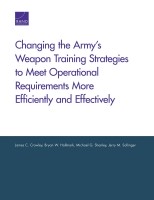| 来源类型 | Research Reports
|
| 规范类型 | 报告
|
| ISBN | 9780833082619
|
| 来源ID | RR-448-A
|
| Changing the Army's Weapon Training Strategies to Meet Operational Requirements More Efficiently and Effectively |
| James C. Crowley; Bryan W. Hallmark; Michael G. Shanley; Jerry M. Sollinger
|
| 发表日期 | 2014
|
| 出版年 | 2014
|
| 页码 | 100
|
| 语种 | 英语
|
| 结论 |
Weapon strategy support of operational requirements and unit readiness processes- Current small arms training standards do not include many combat critical engagement tasks and skills.
- Current weapon training strategies do not align with progressive unit manning and training readiness strategies, and better alignment could achieve needed readiness levels more efficiently.
Potential of training technologies to enhance weapon training strategies- Virtual technologies are already used extensively in weapon training strategies.
- Training strategies could be improved through better use of training technologies, but such improvement will require effort and study.
Weapon training strategy development processes- Proponents develop weapon training strategies with little Army-level guidance and direction.
- Processes are adequate to support evolutionary improvement but not the major changes that may be needed to support changed operational requirements and unit readiness processes and to exploit the potential of training technologies.
- Processes for integrating weapon training strategies and the resources to support them internally (e.g., ammunition, ranges and targetry, and simulators) and with other training strategy components (e.g., mission command and tactical unit maneuver) are informal rather than systematic.
- A lack of data on unit training practices undercuts the ability to make needed improvements.
|
| 摘要 |
- Review and improve weapon training standards to ensure they include all combat-critical engagement skills.
- Improve the alignment of weapon training strategies with changing unit manning and training readiness strategies.
- Review and improve weapon training strategies to ensure that the mix of live and virtual simulator modalities supports greater effectiveness and efficiency.
- Further define Army-level processes for developing, improving, and coordinating weapon training strategies.
- Collect and analyze data on unit weapon training programs and proficiency levels to better support the development of weapon training strategies.
- Develop and improve weapon training strategies as part of a larger, integrated training strategy development process.
|
| 主题 | Military Education and Training
; Military Equipment
; Operational Readiness
; United States Army
|
| URL | https://www.rand.org/pubs/research_reports/RR448.html
|
| 来源智库 | RAND Corporation (United States)
|
| 资源类型 | 智库出版物
|
| 条目标识符 | http://119.78.100.153/handle/2XGU8XDN/107844
|
推荐引用方式
GB/T 7714 |
James C. Crowley,Bryan W. Hallmark,Michael G. Shanley,et al. Changing the Army's Weapon Training Strategies to Meet Operational Requirements More Efficiently and Effectively. 2014.
|
|
文件名:
|
x1495316372070.jpg
|
|
格式:
|
JPEG
|

|
文件名:
|
RAND_RR448.pdf
|
|
格式:
|
Adobe PDF
|
除非特别说明,本系统中所有内容都受版权保护,并保留所有权利。